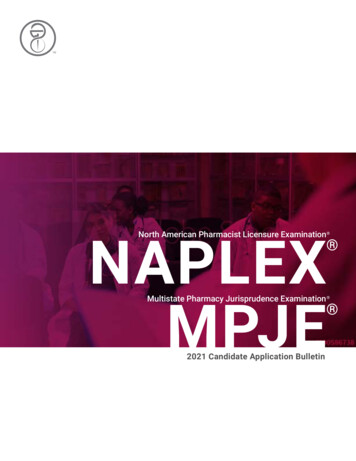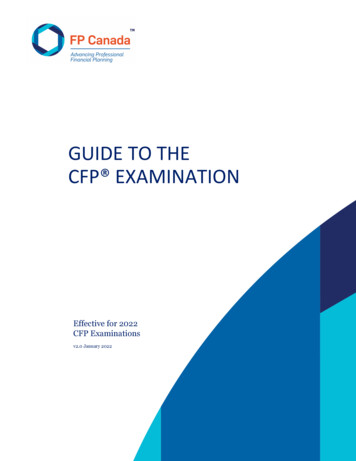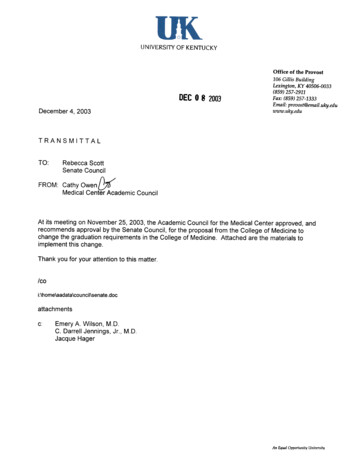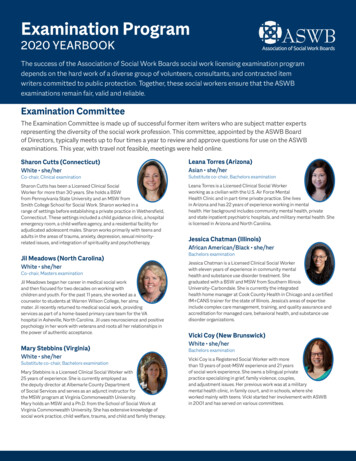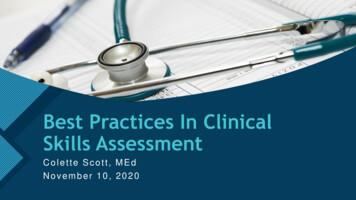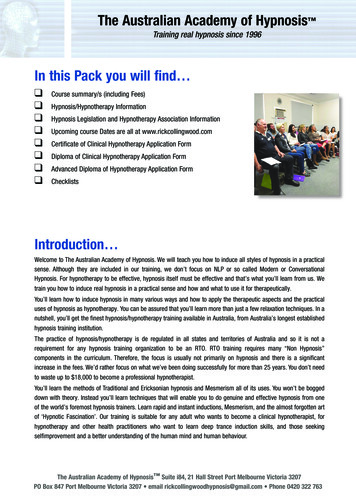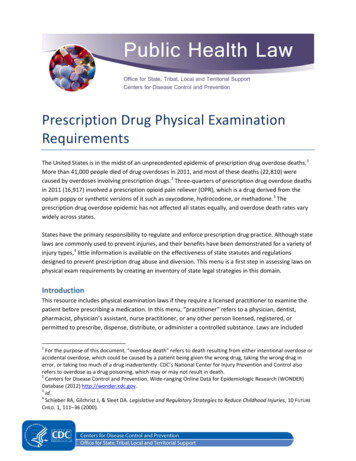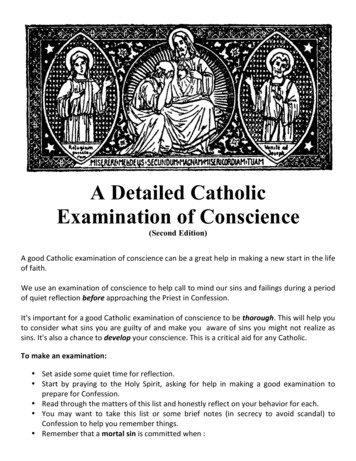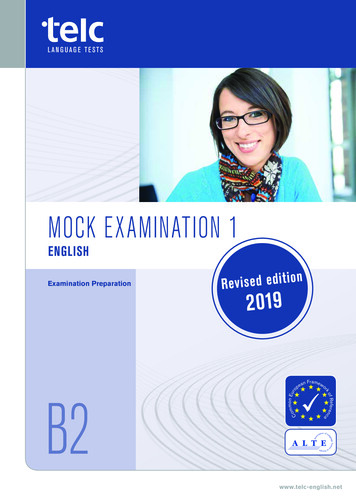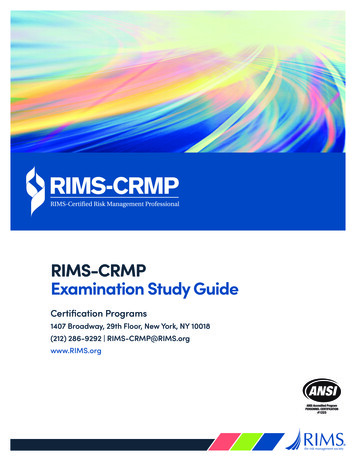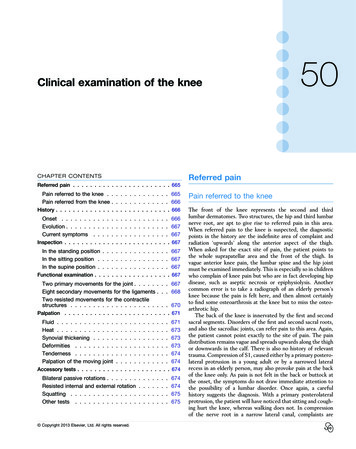
Transcription
Clinical examination of the kneeReferred painCHAPTER CONTENTSReferred pain . . . . . . . . . . . . . . . . . . . . . . .665Pain referred to the knee . . . . . . . . . . . . . . . 665Pain referred from the knee . . . . . . . . . . . . . . 666History . . . . . . . . . . . . . . . . . . . . . . . . . . .666Onset . . . . . . . . . . . . . . . . . . . . . . . . . 666Evolution . . . . . . . . . . . . . . . . . . . . . . . 667Current symptoms . . . . . . . . . . . . . . . . . . 667Inspection . . . . . . . . . . . . . . . . . . . . . . . . .667In the standing position . . . . . . . . . . . . . . . . 667In the sitting position . . . . . . . . . . . . . . . . . 667In the supine position . . . . . . . . . . . . . . . . . 667Functional examination . . . . . . . . . . . . . . . . . .667Two primary movements for the joint . . . . . . . . 667Eight secondary movements for the ligaments . . . . 668Two resisted movements for the contractilestructures . . . . . . . . . . . . . . . . . . . . . . . 670Palpation . . . . . . . . . . . . . . . . . . . . . . . . .Fluid . . . . . . . . . . . . . . . . . . . . . . . . . .Heat . . . . . . . . . . . . . . . . . . . . . . . . . .Synovial thickening . . . . . . . . . . . . . . . . . .Deformities . . . . . . . . . . . . . . . . . . . . . .Tenderness . . . . . . . . . . . . . . . . . . . . . .Palpation of the moving joint . . . . . . . . . . . . .Accessory tests . . . . . . . . . . . . . . . . . . . . . .Bilateral passive rotations . . . . . . . . . . . . . . .Resisted internal and external rotation . . . . . . . .Squatting . . . . . . . . . . . . . . . . . . . . . . .Other tests . . . . . . . . . . . . . . . . . . . . . . Copyright 2013 Elsevier, Ltd. All rights n referred to the kneeThe front of the knee represents the second and thirdlumbar dermatomes. Two structures, the hip and third lumbarnerve root, are apt to give rise to referred pain in this area.When referred pain to the knee is suspected, the diagnosticpoints in the history are the indefinite area of complaint andradiation ‘upwards’ along the anterior aspect of the thigh.When asked for the exact site of pain, the patient points tothe whole suprapatellar area and the front of the thigh. Invague anterior knee pain, the lumbar spine and the hip jointmust be examined immediately. This is especially so in childrenwho complain of knee pain but who are in fact developing hipdisease, such as aseptic necrosis or epiphysiolysis. Anothercommon error is to take a radiograph of an elderly person’sknee because the pain is felt here, and then almost certainlyto find some osteoarthrosis at the knee but to miss the osteo arthrotic hip.The back of the knee is innervated by the first and secondsacral segments. Disorders of the first and second sacral roots,and also the sacroiliac joints, can refer pain to this area. Again,the patient cannot point exactly to the site of pain. The paindistribution remains vague and spreads upwards along the thighor downwards in the calf. There is also no history of relevanttrauma. Compression of S1, caused either by a primary postero lateral protrusion in a young adult or by a narrowed lateralrecess in an elderly person, may also provoke pain at the backof the knee only. As pain is not felt in the back or buttock atthe onset, the symptoms do not draw immediate attention tothe possibility of a lumbar disorder. Once again, a carefulhistory suggests the diagnosis. With a primary posterolateralprotrusion, the patient will have noticed that sitting and cough ing hurt the knee, whereas walking does not. In compressionof the nerve root in a narrow lateral canal, complaints are
The Kneerelated to walking and standing, whereas bending usuallyrelieves the pain.Pain referred from the kneeLesions of the knee are usually located accurately by thepatient at or in the knee. Sometimes an impacted loose bodycomplicating osteoarthrosis can cause pain referred down theleg and slightly up the thigh but this is rather exceptional.HistoryKnee problems are always difficult to evaluate and every pos sible assistance is needed to make a proper diagnosis. A chrono logical history, as summarized in Box 50.1, is therefore the first,and sometimes even the most important, element. Cyriax usedto say that one who ‘doesn’t have a diagnosis after the history,will hardly get one after the clinical examination’.Age is a very important factor because some disorders at theknee appear at a certain time of life only. Anterior knee painin an adolescent can be the outcome of Osgood–Schlatterdisease, whereas the same pain in a 30-year-old sportsman isthe result of infrapatellar tendinitis and in a 50-year-old ladypatellofemoral arthrosis. Symptoms of internal derangement ina 17-year-old boy almost certainly indicate osteochondritis dis secans, while in a 25-year-old sportsman they may suggest ameniscus lesion and in a 60-year-old lady are probably theresult of impaction of a small loose body.The patient should be questioned about occupation andsporting activities.Box 50.1Summary of history taking Age, sex, occupation and sport Site of pain Onset Trauma Mechanism Immediate symptoms Symptoms after 24 hours Non-traumatic Sudden or gradual onset What affects it? Evolution Better/worse Changing localization Treatments and results Current symptoms LocalizationSwellingInfluence of movementsInstabilityTwingesClicks666In knee problems there are three important symptoms thatprovide a great deal of information: ‘locking’, ‘twinge’ and a‘feeling of giving way’. Because the meaning of these words isnot always totally understood and patients frequently confusethem, it is vital to describe what exactly is meant when askingabout these symptoms. Locking: sudden (painful) limitation occurs during amovement, whereas other movements are free andpainless. The knee can be locked in flexion (extensionbeing limited) or extension (flexion being impossible). Twinge: a sudden, sharp and unexpected pain is felt. Forexample, the patient feels abrupt, unforeseen and sharppain at the inner side of the knee during walking. Thepain disappears immediately and normal walking againbecomes possible. Feeling of giving way: this is the typical sensation ininstability – a sudden feeling of weakness. It feels as if theknee cannot bear the body weight during a particularmovement. The knee tends to ‘collapse’.In order to work out the diagnosis systematically andchronologically, it is as well to start with the onset of thesymptoms before concentrating on symptoms at the time ofexamination.Onset When did it start? Is this an acute, subacute or chronicproblem? How did it start? Did the pain come on for no apparentreason or was there an injury?If there was traumaDescribe the exact mechanism: In what position were the body and the leg? What forces were acting on the knee?Describe the immediate symptoms: Where was the initial pain? At one side, all over or insidethe joint? Was there any swelling? Immediately or after some time?An immediate effusion is always haemorrhagic andtherefore indicates a serious lesion. If a swelling appearsafter some time, it is the consequence of a synovialreaction. Did the knee give way? Immediately or after some time? Was there any locking? If so, was the knee locked inflexion (which is typical for meniscal lesions) or wasit in extension (as in impacted loose bodies fromosteochondritis dissecans)? How did the knee becomeunlocked? By manipulation (meniscus) or spontaneously(loose body)? Were you still able to walk home after the accident?If there was no trauma Did the pain come on suddenly or gradually? What were you doing when the pain first appeared?
Clinical examination of the knee Describe the first symptoms. These may includelocalization, swelling, locking or loss of function(see above).EvolutionIn long-standing cases or in traumatic conditions, it is veryimportant to have an exact idea of the evolution of thecomplaints. Did the pain change from one side of the joint to the otheror did the pain spread? Pain moving from one side of thejoint to another is characteristic of a loose body: thelocalization of the pain travels with the impacted loosefragment. What was the evolution of the swelling? For how long were you disabled? What treatment did you have and to what effect? Have there been any recurrences? If so, what broughtthem on and how did they progress?Current symptomsCHAPTER 50the cause is a valgus position of the heel and inversion of theforefoot, appropriate measures can be taken. Excessive genuvalgum deformity in elderly patients may suggest osteitisdeformans. The view from the side detects any recurvatum orlack of complete extension. Observation for tibial torsion isdone standing above the patient’s knees and looking down wards along the tibial tuberosity and anterior tibial crest. Thecoronal plane of the knee is then compared with an imaginaryline connecting the medial and lateral malleoli of the ankle.Tibial torsion between 0 and 40 is normal.In the sitting positionThe most important observations of the patellar position aremade with the patient seated on the examination table, thelegs hanging free and the knees flexed to 90 . The examinerfirst assesses the patellar position and the position of the tibialtuberosity and patellar ligament by viewing the knee from thelateral aspect. Thereafter the examiner views the knees fromthe anterior aspect while the patient holds both knees together.Normally positioned patellae face straight ahead. Malalign ment of the kneecap is seen as a patella ‘looking’ up and overthe shoulders of the examiner (see p. 722).Finally, the current complaint is discussed. Describe the exact localization. What brings the pain on? Do you have nocturnal pain or morning stiffness? Pain atnight usually indicates a high degree of inflammation. Itoccurs in acute ligamentous lesions, haemarthrosis andarthritis. Long-standing morning stiffness is usually anindication of rheumatic inflammation. What is the effect of going upstairs and downstairs, andwhich is the more troublesome? Going downstairs loadsnot only the extensor mechanism but also the posteriorcruciate ligament and the popliteus tendon. Goingdownstairs is also very painful in impacted loosebodies. Do you have twinges? Very often, a twinge means animpacted loose body or a meniscus. Does the knee give way? Does it actually give way or justfeel as though it might? Does the knee click or grate? Have any other joints been affected?At the end of history taking, patients must be asked about theirgeneral state of health.InspectionIn the standing positionThe lower extremities are first viewed with the patient stand ing. Alignment of the femur, varus or valgus positions of thelower leg, pronation of the feet and alignment of the patellaare observed from the front. Some genu valgum deformity inchildren is normal and usually disappears with growth. WhenIn the supine positionThe supine-lying position is the best from which to observeswelling at the knee joint.Diffuse swelling indicates fluid in the joint and/or synovialswelling. In advanced arthritis or in large effusions of blood,the knee may adopt a slightly flexed position.Diffuse swelling with muscular wasting may indicate severeand long-standing arthritis. Swelling with reddening of the skinsuggests sepsis or gout.Localized swellings are caused by bony outcrops, cysts orinflamed bursae, such as a prepatellar or infrapatellar bursa,a semitendinosus bursa, a bursa under the medial collateralligament, a lateral or medial meniscus cyst or a Baker’s cyst.Functional examinationThe routine clinical examination of the knee consists of 10passive movements, two for the joint and eight for the liga ments, and two resisted movements (Table 50.1). If signswarrant, or if suspicion of meniscal lesions or instability arisesfrom the history, complementary tests can be performed.Palpation for tenderness is only carried out along the struc ture identified by the functional examination and therefore isonly performed after the functional examination. However,palpation for heat, fluid and synovial thickening is performedbefore the functional examination.Two primary movements for the jointAs in the elbow, the range of rotation becomes restrictedonly in advanced arthritis. Therefore extension and flexion667
The Knee(Fig. 50.1) are the two movements used to test the mobilityof the joint.now performed by simultaneous upward movement of the heeland downward pressure on the tibia.ExtensionFlexionNormally, the knee can be extended until the tibia comesinto line with the femur, but in young people some hyperex tension can occur and is normal. Extension is limited by theposterior cruciate ligament and the posterior capsule. Theend-feel is hard.The evaluation of the end-feel during extension is extremelyimportant and can only be tested if a correct technique is used.One hand takes the heel of the patient; the fingers of the otherhand support the knee, while the thumb presses on the tibia,just below the patella. A rapid, short extension movement isA normal knee can be flexed until the heel reaches the buttock.Flexion is normally limited by contact between the thigh andcalf muscles; the end-feel is therefore of the extra-articulartype – softish.A painful arc during flexion–extension is rather exceptional.When present, it indicates an impacted loose body, a tornmeniscus or localized erosion of the articular edge of the femur.A painful arc can also be present in lesions of the iliotibial tract(friction syndrome or bursitis). Here pain is elicited as the tractrides over the lateral femoral condyle.Eight secondary movementsfor the ligamentsTable 50.1 Functional examinationTestingStretching the ligaments tests them for pain and laxity.Movements1. Test for heat, swelling, synovial thickening2. Testing l rotationAnterior drawer testMedial shearingValgusLateral rotationPosterior drawer testLateral shearingResisted testsResisted flexion(Resisted medialrotation)Resisted extension(Resisted lateralrotation)3. Retest for heat, swelling, tenderness(a)Valgus strainStrong valgus movement applied with counterpressure at thelateral femoral condyle tests the medial collateral ligament(Fig. 50.2a). Normally, this is done in full extension. In a minorsprain or in a minor degree of instability resulting from previ ous overstretching, pain and laxity are probably better dis closed if the test is repeated in slight flexion (30 ).Varus strainStrong varus movement is applied during counterpressure atthe medial femoral condyle and tests the lateral collateral liga ment (Fig. 50.2b). Again, the test can be repeated in slightflexion (30 ).(b)Fig 50.1 Extension (a) and flexion (b) of the knee.668
Clinical examination of the knee(a)CHAPTER 50(b)Fig 50.2 Valgus (a) and varus (b) movement.(a)(b)Fig 50.3 Lateral (a) and medial (b) rotation.Lateral rotationLateral rotation of the knee puts stress on the medial coronaryligament and the posterior fibres of the medial collateral liga ment. The knee is flexed to a right angle and the heel rests onthe couch. To prevent rotation in the hip, the examiner placesthe contralateral shoulder against the knee, the arm under thelower leg and a hand under the heel. The other hand is placedat the inner side of the foot, which is pressed upwards in dor siflexion. Lateral rotation is now easily performed by using thefoot as a lever (Fig. 50.3a). The normal end-feel is elastic.Medial rotationMedial rotation puts stress on the lateral coronary ligament andthe anterior cruciate ligament. The hip and knee are flexed to669
The Kneeright angles. The lower leg is supported by the contralateralforearm of the examiner. The hands are clasped tightly aboutthe patient’s heel, which is forced into dorsiflexion. With acombined movement of both wrists, the leg is turned intomedial rotation (Fig. 50.3b). In order to protect the lateralligaments of the ankle, it is important to exert pressure at theankle and not beyond the calcaneocuboid joint line. The normalend-feel is elastic.hand at the lateral tibial condyle, with the heel of the otherhand at the medial femoral condyle. By applying a strong shear ing strain, an attempt is made to move the tibia medially onthe femur (Fig. 50.5a). Pain may be elicited when a loose bodyis present. In a tear of the lateral meniscus, this manœuvre candisplace part of the meniscus to the other side of the femoralcondyle. A loud click is then heard and the full range of passiveextension is immediately lost.Anterior drawer testLateral shearing strainThe knee is flexed to a right angle, and the examiner sits onthe patient’s foot and places one hand on the patella. The otherhand is placed at the back of the upper tibia, which is drawnforwards with a strong jerk to test for pain if the anterior cruci ate ligament is damaged (Fig. 50.4a). The anterior drawer testin 30 of flexion (‘Lachman’s test’) seems to be more precisein disclosing elongation or rupture in the anterior cruciate liga ment (see Ch. 53).This action is the reverse of medial shearing strain. The heelof one hand is placed on the lateral femoral condyle and theheel of the other on the medial tibial condyle (Fig. 50.5b). Astrong shearing force moves the tibia laterally on the femur andmay provoke a click when a loose body or a longitudinal tearof the medial meniscus is present. It also elicits pain when astrain of the posterior cruciate ligament is present.Posterior drawer testTwo resisted movementsfor the contractile structuresThe examiner once again sits on the patient’s foot. One handis placed on the tibial tuberosity, while the other rests at theback of the knee. A strong backward jerk is exerted on thetibia to test the integrity of the posterior cruciate ligament(Fig. 50.4b). In a normal joint, no movement takes place andthe test is completely painless.Medial shearing strainFor convenience, resisted flexion and extension are tested withthe patient supine, but stronger force can be exerted if he orshe is prone.Resisted extensionThe knee is held at a right angle. The examiner sits oppositethe patient, interlocks the fingers and places the heel of oneThe knee is kept slightly bent. The examiner places onearm under the patient’s knee. The other hand is placed onthe distal end of the tibia, where it resists extension by the(a)(b)Fig 50.4 The anterior (a) and posterior (b) drawer tests.670
Clinical examination of the kneeCHAPTER 50(a)(b)Fig 50.5 Medial (a) and lateral (b) shearing strain.patient (Fig. 50.6a). Pain and weakness are noted. If thereis any pain, a lesion of the quadriceps mechanism is likely.If there is any weakness, a lesion of the nerve supply, usuallythe third lumbar nerve root, is present. Pain and weaknessoccur in a fractured patella or after a major rupture of themuscle belly.Resisted flexionThe hip and knee are bent at right angles. The patient’s heelis supported by the hands of the examiner. The patient triesto move the heel downwards while the examiner applies strongcounterpressure (Fig. 50.6b).If flexion is painful, the test is repeated, this time inalmost full extension, to disclose lesions of the tibiofibularligament and the posterior cruciate ligament. Then, withthe patient in a sitting position, medial and lateral rotation istested against resistance while the knee is held passively flexed.This test distinguishes between lateral (biceps) and medial(semimembranosus, semitendinosus and popliteus) rotators ofthe knee.PalpationPalpation for warmth and fluid in the stationary joint is donebefore the clinical examination, and palpation for synovialthickening, tenderness, warmth and irregularities is done afterthe clinical examination. Finally, crepitus is sought duringmovement (Box 50.2).FluidFluid in the knee joint is a sign that is common to manydisorders (traumatic, inflammatory or crystalline). Therefore,‘water on the knee’ is only a statement of a sign, never a diag nosis. Testing for fluid in the joint can be done in three ways.671
The Knee(a)(a)(b)Fig 50.7 Testing for fluid in the joint by patellar tap (a) and byeliciting fluctuation (b).(Fig. 50.7a). If fluid is present, the patella is felt to move.When it strikes the femur, a palpable tap is felt, followed byan immediate upward movement. This is the sensation of anice-cube pushed downwards in a glass of water: although thepatella moves downwards, the pressure of the fluid immedi ately shifts the bone upwards against the palpating finger. In anormal knee, the patellar tap is not elicited.Eliciting fluctuation(b)Fig 50.6 Resisted extension (a) and flexion (b).Box 50.2Palpation for: Fluid (three tests)HeatSynovial ar tapThis is the classic test. Manual pressure empties the suprapa tellar pouch and moves the fluid under the patella. In the mean time, the thumb and middle finger of the other hand are usedto press on the medial and lateral recesses until they empty.Any fluid now lies between the patella and femur. Next theindex finger of the lower hand pushes the patella downwards672The examiner’s thumb and index finger are placed at each sideof the patient’s knee, just beyond the patella. With the inter digital web I–II of the other hand, the examiner squeezes thesuprapatellar pouch, pushing all the fluid downwards under thepatella, which forces the two fingers of the palpating handapart (Fig. 50.7b). This sensitive test will detect even verysmall volumes of fluid and enables an experienced examiner todifferentiate between blood and clear fluid. Blood fluctuatesen bloc, like a mass of jelly, whereas a clear effusion flowslike water.Visual testing by eliciting fluctuationThis test is not strictly palpation but relies on vision. Strokingin a sweeping motion with the back of the hand over the lateralrecess and the suprapatellar pouch moves the fluid upwardsand medially (Fig. 50.8a). In a minor effusion, all the fluid ismoved to the medial part of the suprapatellar pouch. Thelateral recess is then empty and can be seen as a groove betweenpatella and lateral femoral condyle. Sweeping with the back ofthe hand over the suprapatellar pouch and downwards over themedial recess will now transfer the fluid laterally (Fig. 50.8b),where a small prominence appears. This is the most delicatetest for effusion in the knee joint and demonstrates as little as2 or 3 mL of fluid.
Clinical examination of the kneeCHAPTER 50(a)Fig 50.9 Synovial swelling is most easily detected at the medialand lateral condyles of the femur. Metastases Osteitis deformans Ligamentous lesions.Synovial thickening(b)Fig 50.8 Visual testing for fluid by eliciting fluctuation. (a) Asweeping motion over the lateral recess moves the fluid upwardsand medially. (b) Sweeping downwards over the medial recesstransfers the fluid laterally where a small prominence appears.Synovial thickening is a vital clinical finding. It indicatesprimary inflammation of the synovia and differentiates thisfrom a secondary synovitis.Synovial swelling is best detected at the medial and lateralcondyles of the femur, about 2 cm posterior to the medial andlateral edges of the patella (Fig. 50.9). Here the synovium liesalmost superficially, covered only by skin and subcutaneous fat.It is palpated by rolling the structures between fingertip andbone. Normally nothing except skin can be felt. In synovialthickening, a dense structure can be felt.HeatDeformitiesPalpation for heat is performed before and after the functionalexamination.Heat, whether localized or generalized, means that thelesion is in an active stage. Generalized heat indicates capsuli tis. Localized heat, sometimes only appearing after the clinicalexamination, indicates the presence of a minor lesion.Heat appears in the following conditions:After a fracture, or when osteophytes are present, bonydeformities may be felt. Previous Osgood–Schlatter diseaseresults in a prominence of the tibial tuberosity. Long-standinginfrapatellar tendinitis may cause a bony outcrop at the patellartip. Calcified areas in the suprapatellar pouch may form apalpable thickening but are not of clinical significance. In ostei tis deformans at the tibia, the sharp anterior edge of the tibialplateau may be lost and is eventually accompanied by localizedwarmth.Localized swellings may be felt all over the knee.Some swellings are more obvious with the knee straight,whereas others are thrown into relief by flexing the knee.Ganglia and cysts related to tendons or menisci feel tense oreven hard. Inflamed bursae feel softer and bimanual palpationcan usually disclose some fluctuation. Blood in the joint Recent trauma or operation Arthritis of rheumatoid, crystalline, traumatic or bacterialorigin Loose body impacted in an osteoarthrotic joint or animpacted meniscus Fracture673
The KneeTendernessResisted internal and external rotationTenderness can be sought in the structure identified by thehistory and functional examination, provided the lesion lieswithin reach of the fingers. The two knees must always becompared carefully. Because most of the structures affectedcan be palpated, great diagnostic accuracy is possible.The patient sits on the table, the knee flexed to a right angleand the legs hanging over the edge. The examiner holds thefoot in dorsiflexion and asks the patient to press outwardsand inwards, meanwhile maintaining the neutral positionwith both hands. Internal (medial) rotation tests the medialhamstrings and popliteus (Fig. 50.10a). External (lateral) rota tion tests the biceps femoris and the upper tibiofibular joint(Fig. 50.10b).Palpation of the moving jointThis can give an idea of the state of the opposed surfaces ofthe articular cartilage. However, it is important to rememberthat crepitus, cracking and clicking may very well appearwithout any pain or disablement. Some fine crepitus is alsonormal in middle-aged individuals. In contrast, rough crepitusindicates marked fragmentation of the surface of articular car tilage and hard creaking of bone against bone indicates thatcartilage has been completely eroded. In patellofemoral arthro sis, the marked crepitus characteristic of this condition is feltonly during squatting.Accessory testsThese tests, summarized in Box 50.3, are performed only ifthe history or clinical examination warrants them. Meniscustests are thus performed when the history includes periods oflocking.Stability tests are used when the patient mentions a feelingof giving way, or when some laxity is detected during theroutine functional examination. Patellofemoral tests are usedif the history is that of anterior knee pain or patellofemoraldysfunction.Bilateral passive rotations(a)The range of knee rotation can best be compared with that ofthe contralateral side by performing the movement simultane ously at both knees. The patient lies prone and flexes bothknees to a right angle. The examiner stands at the end of thecouch, grasps the patient’s feet, pushes them in dorsiflexionand then simultaneously rotates both feet laterally to testexternal rotations and medially to test internal rotations. Rangeof movement and end-feel are compared.Box 50.3Accessory tests Bilateral passive internal and external rotationResisted internal and external rotationStability testsMeniscus testsPatellofemoral testsSquatting(b)Fig 50.10 Resisted internal (a) and external (b) rotation.674
Clinical examination of the kneeCHAPTER 50Box 50.4Summary of the clinical examination of the kneeInspection Standing Sitting Supine-lyingBasic functional examination Two primary movements for the joint Passive flexion Passive extension Eight secondary movements for the ligaments Valgus strain Varus strain Lateral rotation Medial rotation Anterior drawer test Posterior drawer test Medial shearing strain Lateral shearing strain Two resisted movements Extension FlexionPalpation FluidSynovial thickeningDeformitiesTendernessPalpation of the moving jointAccessory tests Bilateral passive internal and external rotationResisted internal and external rotationStability testsMeniscus testsPatellofemoral testsSquattingSquattingOther testsPalpation during squatting is performed when a lesion at thepatellofemoral joint is suspected. The palpating hand ascertainswhether there is crepitus, which is typical in patellofemoraldisorders.Tests for capsuloligamentous instability, meniscal lesions andpatellofemoral disorders are described in Chapters 52, 53 and54 respectively.Clinical examination of the knee is summarized in Box 50.4.675
The back of the knee is innervated by the first and second sacral segments. Disorders of the first and second sacral roots, . recess in an elderly person, may also provoke pain at the back of the knee only. As pain is not felt in the back or buttock at the onset, the symptoms do not draw immediate attention to .


